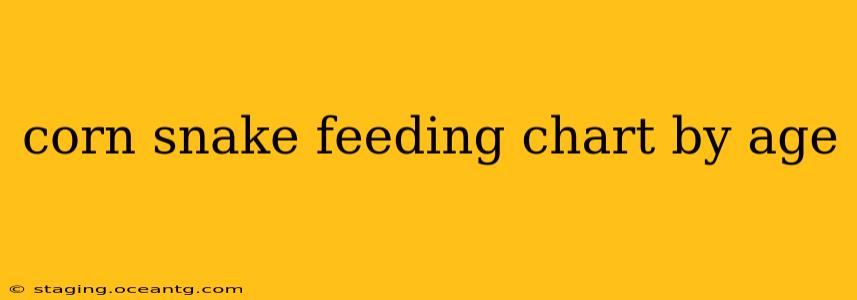Corn snakes ( Pantherophis guttatus) are popular pets due to their docile nature and relatively easy care. A crucial aspect of responsible corn snake ownership is understanding their feeding requirements, which change as they grow. This comprehensive guide provides a detailed corn snake feeding chart by age, addressing common questions and concerns.
Understanding Corn Snake Growth Stages
Corn snakes go through distinct growth stages, each with specific dietary needs. Understanding these stages is key to providing proper nutrition and ensuring your snake thrives. We'll break it down into age ranges for clarity:
-
Hatchlings (0-3 months): This is a period of rapid growth. They require frequent, smaller meals to support their development.
-
Juveniles (3-12 months): Growth continues, albeit at a slower pace than hatchlings. Feeding frequency can be gradually reduced.
-
Adults (12+ months): Growth slows significantly. Adults require fewer and larger meals.
Corn Snake Feeding Chart by Age
The following chart provides a general guideline. Remember that individual snakes may have slightly different appetites and growth rates. Always monitor your snake's body condition and adjust feeding accordingly. An overweight snake is just as unhealthy as an underweight one.
| Age Range | Feeding Frequency | Prey Size (approx.) | Notes |
|---|---|---|---|
| Hatchlings (0-3 months) | Every 2-3 days | 2-4 inches | Offer appropriately sized pinkies (newborn mice) or fuzzy mice. |
| Juveniles (3-12 months) | Every 3-5 days | 4-6 inches | Gradually increase prey size as the snake grows. Can transition to adult mice. |
| Adults (12+ months) | Every 5-7 days, or even less frequently | 6-8 inches or larger | Size of prey should be roughly the width of the snake's body. |
Frequently Asked Questions (FAQ)
Here we'll address common questions regarding corn snake feeding:
How often should I feed my baby corn snake?
Baby corn snakes (hatchlings) need to be fed every 2-3 days. This frequent feeding is crucial for supporting their rapid growth. They should be offered a pinky (newborn mouse) or small fuzzy mouse appropriately sized for their body width. Never offer prey larger than the width of their widest point (usually around the body, not the head).
What size mouse should I feed my corn snake?
The size of the mouse should correspond to the size of your snake. Generally, the prey should be about the same width as your snake's body. Overfeeding a young snake can cause digestive issues and health problems; underfeeding can stunt its growth.
My corn snake refused its food, what should I do?
There are several reasons why your corn snake might refuse food. This could be due to:
- Shedding: Snakes often refuse food a few days before and during shedding.
- Temperature: Ensure your enclosure maintains the correct temperature gradient.
- Stress: Changes in environment or handling can stress a snake, causing it to refuse food.
- Illness: If your corn snake refuses food consistently, consider consulting a veterinarian specializing in reptiles.
How do I know if my corn snake is overweight or underweight?
A healthy corn snake should have a slight taper from its widest point to its tail. You should be able to feel its ribs with gentle pressure, but not see them prominently. An overweight snake will have a significantly thicker body with rounded edges and a bulging belly. An underweight snake will appear thin and bony. Consult a reptile veterinarian if you are unsure about your snake’s weight.
Can I feed my corn snake other prey besides mice?
While mice are the most common and recommended prey, some experienced keepers might occasionally offer rats. However, it's crucial to stick to mice unless you're well-versed in reptile nutrition and have guidance from a reptile veterinarian.
Conclusion
Providing your corn snake with an appropriate diet is essential for its health and longevity. By following this feeding chart as a guideline and paying attention to your snake’s individual needs, you can ensure your reptile companion thrives. Remember to always consult with a veterinarian specializing in reptiles for any concerns regarding your snake’s health or feeding habits. They are invaluable resources for ensuring proper care.
